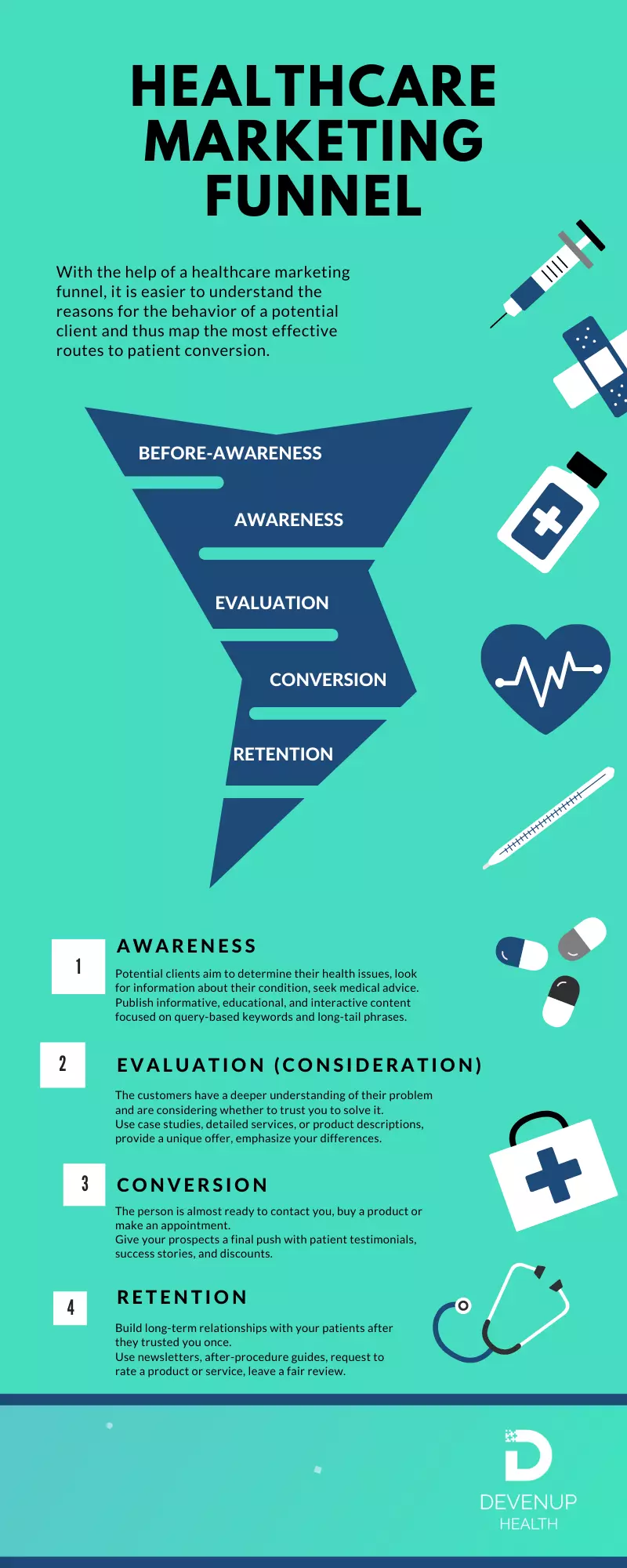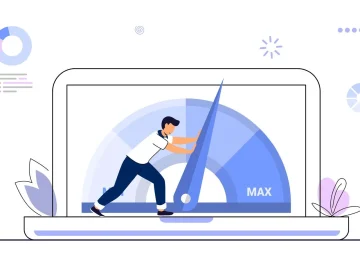Effective marketing and the use of its various tools is a condition for the growth of any business in today’s world. And this includes the medical field. You have probably heard many times about the concept of a marketing funnel for doctors. It can be counted among one of the many marketing tools that can attract more patients. And – even better – convert them into long-term patients.
What is a marketing funnel?
A marketing funnel is a path that potential customers travel through from the moment they discover your brand to the moment of becoming your patients or clients.
In different industries, such as B2B, education, or retail, this is also known as a sales funnel, or a conversion funnel. The principles of its operation are the same for any industry.
Marketing funnel automation is a multi-stage process. This model commonly involves four steps of patient engagement with your brand. The main thing is that their essence is the same for any healthcare marketing funnel, including therapist, cosmetologist, dental marketing funnel, and other niches related to medicine.

Why the marketing funnel matters to doctors
The person does not decide to make an appointment at the snap of their fingers, except when he needs urgent help, of course. When it comes to health, spontaneous purchases and appointments are a thing of the past. People have become much more serious about their health as of late and are more selective in their choice of healthcare provider. To compound this, the internet made it possible to get acquainted with different options in just a few minutes so that people can choose the best options for themselves.
So if you want to increase your client flow and build longer-lasting relationships with patients, the right marketing funnel is your ace up your sleeve.
With the help of a marketing funnel, it is easier to understand the reasons behind a potential client’s behavior. And thus map the most effective routes to patient conversion.
Benefits of a marketing funnel
- Detailed insights about a customer’s journey. You’ll know at what particular stage of interacting with your brand your prospects dropped off before making an appointment or buying your product;
- Consistency of your marketing strategy. No need to worry about the next step of engaging a potential client if you act according to a plan based on marketing data and insights.
- It helps to reduce the number of errors in your marketing strategy and avoid leaking potential customers to your competitors.
- Marketing funnel automation saves process time and effort. Setting up an effective marketing funnel once, there’s no need to often change and remodel it.
- An effective funnel increases your brand awareness and value. You settle in people’s minds and they will remember you when they need your service or product.
- It provides you with an opportunity for lead-nurturing. This is another chance to interact with a prospect.
- You obtain more appointments and increased profits.

How to create an effective marketing funnel?
To create a marketing funnel for doctors you should follow the stages your potential patient follows when getting to know your company or services. The best way to make yourself known for today is the Internet and your site itself as the face of your organization or company on the Internet. Looking ahead, a well-optimized website is half the battle. Now let’s consider each stage of a marketing funnel in detail.
What are the marketing funnel stages?
Stage 1: Awareness
During the first stage, potential clients are not sure they even need your medical services. So far, they are trying to determine their health issues, search for information about their condition, seek advice.
What can you do to help a person move to the next stage of the funnel? Publish informative, educational, and interactive basic content in your blog: checklists, guides, infographics, etc., focused on query-based keywords and long-tail phrases. For example, by using the Answer the Public tool, you can find plenty of customers’ searches in the early funnel stage.

Also, be sure to create a variety of content in order to reel in as many visitors as possible. A single article will work for some, while others will look for information on another issue. For instance, someone may need to know about the causes of tooth sensitivity and how to solve this problem. While the other person is looking for advice on how to overcome their fear of going to the dentist. Both are different requests, but it all covers your field! So the task at this stage is to let people find your site and provide as many visitors as possible with content that is relevant and useful to them.
Stage 2: Consideration
It’s normal to lose some people when moving from the Awareness to Consideration stage. At this phase of the healthcare marketing funnel, customers have a deeper understanding of their problem. They are considering whether to trust you to solve it. This is the stage where you can be compared with your competitors.
The most common mistake here is to turn away from this step and try to push a visitor directly to book an appointment. If a prospect has an urgent problem, it might work. But much more people will convert if you use hooks like these:
- Case studies from your medical practice that demonstrate how your service or product helped solve an issue step by step.
- Detailed description of the service or product. What, how, where, how much, why – do not force the person to make an effort in finding answers to these questions.
- Make sure your website is user friendly. If visitors want to run away from your site, flashing their heels, this will also affect their perception of your clinic and services in general.
- Highlight your differences and provide a unique offer. It will be your indisputable advantage when you are compared to your competitors.

Stage 3: Conversion
Now is the time to give the prospects a final push and turn them from potential customers into real ones. The person is almost ready to contact you, buy a product, or make an appointment. Make it easier for the person to move from thought to action by doing the following:
- Patient testimonials
- Success stories
- Discounts
Nudge a potential client by showcasing your product or service benefits, enrolling other people’s positive opinions and experiences, and offering to try your product or service at least once by taking advantage of an attractive discount. This way you give him little or no escape route.
Also, for a successful conversion, it is necessary to create plain conditions for the purchase or booking of an appointment. What does this mean? Offer several payment methods on your website. Let everyone choose the method most convenient for them. Indicate changes in opening hours or any restrictions on attendance. Post a map and comment on how to get to you, so that the person does not have to specifically search for this information.
Stage 4: Retention
This step is rather optional. Some healthcare businesses need it, others do not. Sometimes after the third stage and conversion, you can check the box next to this patient. It depends on your business nature, product, or services.
But the best strategy is not to neglect patients after they trusted you once. Because you have the opportunity to build long-term relationships with them and count on the fact that they will recommend you to their relatives or friends. Your top tools at this stage are:
- Newsletters. Regular email newsletters are a great way to keep patients up to date about your clinic and special offers. They can also be used to provide your patients with current healthcare information. For example, tips on how to protect yourself from seasonal viruses. But don’t be too spammy. No one likes receiving newsletters five times a week.

- After-procedure guides and information that can help to get the most out of your services. This is a checklist of what you can and cannot do after a particular procedure that the patient underwent in your clinic. It will be a great addition to the service and a manifestation of patient care.
- Request to rate a product or service, leave a fair review, and correct commenting on these reviews.
The role of SEO in creating a healthcare marketing funnel
First off, SEO is what makes your website visible. And website visibility is the first condition for targeted people to get to the first stage of the marketing funnel.
Second, a lot of what has been listed can be cleverly achieved with SEO. Keyword research for the right content, the right content for every stage of the funnel, website usability, and improving the site for its competitiveness. These are all the worries of SEO companies. But all of this will positively impact your marketing funnel. It is not the task of SEO specialists to build a marketing funnel for doctors. This connection is rather inverse; funnel improvement is one of the results of effective SEO work.
Thanks to SEO, a well-optimized website filled with the right content turns into your magic compass that will help a potential client navigate your marketing funnel without even realizing it.
Effects of a forceful marketing funnel for doctors
A healthy marketing funnel, which is inseparable from a healthy website, will answer all your conversion concerns, reveal the reasons for failure, and suggest effective ways to increase conversions and make your clients satisfied and coming back.
At what stage is the largest number of prospects eliminated? Let’s say that people don’t even get to the first stage of the funnel, since your site is under the search engines’ mercy and is not visible to people? Or are you aiming for repeat visits and a loyal customer base, while the first visit by a client to your clinic or practice is often the last?
With an in-depth understanding of what a marketing funnel is and how to best implement it into your strategy, you can better understand the reasons for the behavior of potential customers, which means giving them what they need so that they ultimately give you the conversions you need.







